
The Hittites were an Anatolian Indo-European people who formed one of the first major civilizations of Bronze Age West Asia. Possibly originating from beyond the Black Sea, they settled in modern day Turkey in the early 2nd millennium BC. The Hittites formed a series of polities in north-central Anatolia, including the kingdom of Kussara, the Kanesh or Nesha kingdom, and an empire centered on Hattusa. Known in modern times as the Hittite Empire, it reached its height during the mid-14th century BC under Šuppiluliuma I, when it encompassed most of Anatolia and parts of the northern Levant and Upper Mesopotamia.
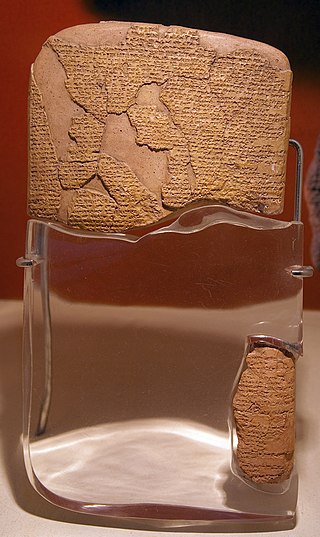
A treaty is a formal, legally binding written contract between actors in international law. It is usually made by and between sovereign states, but can include international organizations, individuals, business entities, and other legal persons.

The Hurrians were a people who inhabited the Ancient Near East during the Bronze Age. They spoke the Hurrian language, and lived throughout northern Syria, upper Mesopotamia and southeastern Anatolia.

Mitanni, earlier called Ḫabigalbat in old Babylonian texts, c. 1600 BC; Hanigalbat or Hani-Rabbat in Assyrian records, or Naharin in Egyptian texts, was a Hurrian-speaking state in northern Syria and southeast Anatolia with Indo-Aryan linguistic and political influences. Since no histories, royal annals or chronicles have yet been found in its excavated sites, knowledge about Mitanni is sparse compared to the other powers in the area, and dependent on what its neighbours commented in their texts.
A vassal state is any state that has a mutual obligation to a superior state or empire, in a status similar to that of a vassal in the feudal system in medieval Europe. Vassal states were common among the empires of the Near East, dating back to the era of the Egyptian, Hittite, and Mitanni conflict, as well as Ancient China.

A peace treaty is an agreement between two or more hostile parties, usually countries or governments, which formally ends a state of war between the parties. It is different from an armistice, which is an agreement to stop hostilities; a surrender, in which an army agrees to give up arms; or a ceasefire or truce, in which the parties may agree to temporarily or permanently stop fighting.

Wilusa or Wilusiya was a Late Bronze Age city in western Anatolia known from references in fragmentary Hittite records. The city is notable for its identification with the archaeological site of Troy, and thus its potential connection to the legendary Trojan War.
Suzerainty includes the rights and obligations of a person, state or other polity which controls the foreign policy and relations of a tributary state, but allows the tributary state internal autonomy. Where the subordinate party is called a vassal, vassal state or tributary state, the dominant party is called a suzerain. The rights and obligations of a vassal are called vassalage, and the rights and obligations of a suzerain are called suzerainty.
The Hebrew Bible makes reference to a number of covenants with God (YHWH). These include the Noahic Covenant set out in Genesis 9, which is decreed between God and all living creatures, as well as a number of more specific covenants with Abraham, the whole Israelite people, the Israelite priesthood, and the Davidic lineage of kings. In form and terminology, these covenants echo the kinds of treaty agreements existing in the surrounding ancient world.
Shattiwaza or Šattiwaza, alternatively referred to as Kurtiwaza or Mattiwaza, was a king of the Hurrian kingdom of Mitanni, who reigned c. 1330-1305 BC.

Barattarna, Parattarna, Paršatar, or Parshatatar was the name of a Hurrian king of Mitanni and is considered to have reigned, as per middle chronology between c. 1510 and 1490 BC by J. A. Belmonte-Marin quoting H. Klengel.

Idrimi was the king of Alalakh c. 1490–1465 BC, or around 1450 BC. He is known, mainly, from an inscription on his statue found at Alalakh by Leonard Woolley in 1939. According to that inscription, he was a son of Ilim-Ilimma I the king of Halab, now Aleppo, who would have been deposed by the new regional master, Barattarna, king of Mitanni. Idrimi would have succeeded in gaining the throne of Alalakh with the assistance of a group known as the Habiru, founding the kingdom of Mukish as a vassal to the Mitanni state. He also invaded the Hittite territories to the north, resulting in a treaty with the country Kizzuwatna.
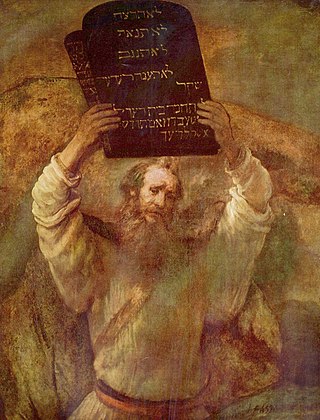
Abrahamic religions believe in the Mosaic covenant, also known as the Sinaitic covenant, which refers to a covenant between the Israelite tribes and their God, including their proselytes, not limited to the ten commandments, nor the event when they were given, but including the entirety of laws that their patriarch Moses delivered from God in the five books of Torah.
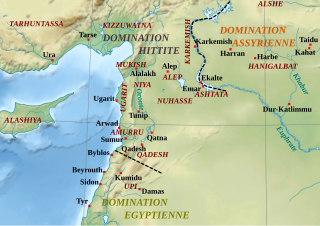
Nuhašše, was a region in northwestern Syria that flourished in the 2nd millennium BC. It was east of the Orontes River bordering Aleppo (northwest) and Qatna (south). It was a petty kingdom or federacy of principalities probably under a high king. Tell Khan Sheykhun has tenatively been identifed as kurnu-ḫa-šeki.

According to the Hebrew Bible, the covenant of the pieces or covenant between the parts is an important event in Jewish theology. In this central narrative God revealed himself to Abraham and made a covenant with him, in which God announced to Abraham that his descendants would eventually inherit the Land of Israel.

Covenanters were members of a 17th-century Scottish religious and political movement, who supported a Presbyterian Church of Scotland and the primacy of its leaders in religious affairs. The name is derived from covenant, a biblical term for a bond or agreement with God.
In religion, a covenant is a formal alliance or agreement made by God with a religious community or with humanity in general. The concept, central to the Abrahamic religions, is derived from the biblical covenants, notably from the Abrahamic covenant. Christianity asserts that God made an additional covenant through Jesus Christ, called the "new covenant".
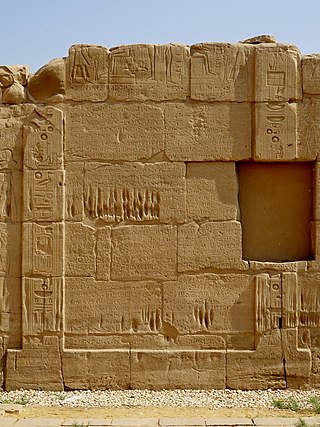
The Egyptian–Hittite peace treaty, also known as the Eternal Treaty or the Silver Treaty, is the only Ancient Near Eastern treaty for which the versions of both sides have survived. It is also the earliest known surviving peace treaty. It is sometimes called the Treaty of Kadesh, after the well-documented Battle of Kadesh that had been fought some sixteen years earlier, although Kadesh is not mentioned in the text. The treaty was concluded between Egyptian pharaoh Ramesses II and king of the Hittite empire Ḫattušili III in c. 1259 BC. Both sides of the treaty have been the subject of intensive scholarly study. The treaty itself did not bring about a peace; in fact, "an atmosphere of enmity between Hatti and Egypt lasted many years" until the eventual treaty of alliance was signed.
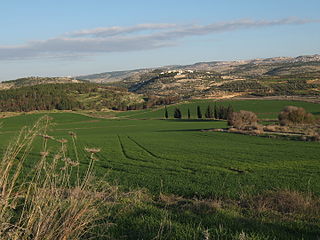
The Land of Israel is the traditional Jewish name for an area of the Southern Levant. Related biblical, religious and historical English terms include the Land of Canaan, the Promised Land, the Holy Land, and Palestine. The definitions of the limits of this territory vary between passages in the Hebrew Bible, with specific mentions in Genesis 15, Exodus 23, Numbers 34 and Ezekiel 47. Nine times elsewhere in the Bible, the settled land is referred as "from Dan to Beersheba", and three times it is referred as "from the entrance of Hamath unto the brook of Egypt".
Adad-Nirari or Addu-Nirari was a king of Nuhašše in the 14th century BC. His identity and succession order is debated as well as the extent of his kingdom which might have included Qatna. Adad-Nirari engaged in a military struggle again the Hittite king Šuppiluliuma I, asking Egypt for help and invading the kingdom of Ugarit, a Hittite vassal. Those actions prompted Šuppiluliuma to invade the region and relive Ugarit. Adad-Nirari's fate is unknown as he disappeared from records.












